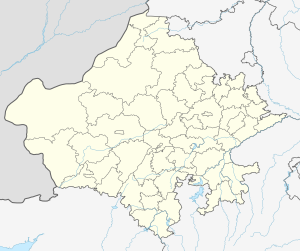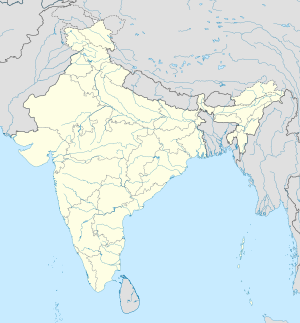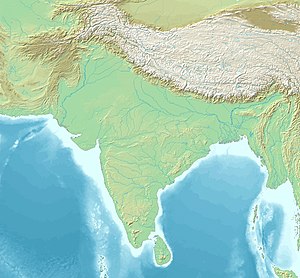The Seige of Ajmer [4] was a military expedition launched by Sultan Mahmud Khalji of Malwa, aimed to conquer and subdue the region of Mewar, which was under the control of the Mewar kingdom. This military expedition was undertaken with the intention of seeking revenge against Rana Kumbha of Mewar. It was a major military conquest carried out during the reign of Mahmud Khalji with the goal of expanding territorial control.[5][4] Although Mahmud was victorious in this campaign, the city was reconquered by Rana Kumbha after a few days.[6]
| Seige of Ajmer | |||||||||
|---|---|---|---|---|---|---|---|---|---|
| Part of Mewar-Malwa Conflict | |||||||||
| |||||||||
| Belligerents | |||||||||
| Malwa Sultanate |
| ||||||||
| Commanders and leaders | |||||||||
| Mahmud Khalji |
| ||||||||
Background
editMahmud Khalji, a prominent ruler of the Malwa Sultanate, undertook several invasions of the Kingdom of Mewar, including the Battle of Mandalgarh and Banas, as well as the Capture of Gagron (1444). While some of these military campaigns proved inconclusive, others resulted in victories for him, though he also faced reverses in certain engagements. In the year 1444, Mahmud Khalji successfully captured the fort of Gagron from Mewar, which was under the control of Palhan Singh. This conquest marked a significant achievement for Mahmud Khalji. Mahmud Khalji initiated a military campaign against Mewar, during which he carried out an invasion of Ajmer.[7] Ajmer was under the control of Mewar, commanded by Gajadhar Singh.[3]
The Battle
editThe fort of Ajmer, which was under the command of Gajadhar Singh and in the sway of Kumbha, was attacked by Mahmud Khalji. Despite a fierce battle that lasted four days, Mahmud Khalji was able to reduce the fort and capture it.[8][9] Many soldiers from Mahmud's army and numerous Rajputs were killed in the battle.[10] Gajadhar Singh and his entire army were also slain during the conflict.[2][11][12][13]
Aftermath
editAfter the successful capture of the fort of Ajmer, Mahmud Khalji oversaw the construction of a mosque within its premises. He appointed his governor, Khwaja Niamatullah, who was given the title of Saif Khan, to manage the Ajmer.[2][14] Makhdum Husain, one of the most celebrated Sufi Shaikhs of Nagaur, was a relative and follower of Shaikh Kabir and was first with his spiritual guide in Gujarat. After Rana Kumbha's defeat at Ajmer in 859/ 1456-7 Makhdum Husain went there to the devastated site of the shrine of Khwaja Muin al-din. He later constructed the shrine over Mu'in al-din's tomb. Ajmer was still under the control of the Malwa Sultan Mahmud Khalji, and he, or his successor, Sultan Ghiyath al-din (873/1468-9 to 905/1499-1500) ordered the construction of a gate to the shrine of the Khwaja.[15] Later Ajmer was retaken by Kumbha.[6]
References
edit- ^ Shokoohy, Mehrdad; Shokoohy, Natalie H. (1993). Nagaur: Sultanate and Early Mughal History and Architecture of the District of Nagaur, India. Royal Asiatic Society. p. 17. ISBN 978-0-947593-09-4."Makhdum Husain, 111 one of the most celebrated Sufi Shaikhs of Nagaur, was a relative and follower of Shaikh Kabir and was first with his spiritual guide in Gujarat. After Rana Kumbha's defeat at Ajmer in 859/ 1456-7 Makhdum Husain went there to the devastated site of the shrine of Khwaja Muin al-din. He later constructed the shrine over Mu'in al-din's tomb. Ajmer was still under the control of the Malwa Sultan Mahmud Khalji, and he, or his successor, Sultan Ghiyath al-din (873/1468-9 to 905/1499-1500) ordered the construction of a gate to the shrine of the Khwaja. convert it into better English in same way."
- ^ a b c Rapson, Edward James; Haig, Sir Wolseley; Burn, Sir Richard; Dodwell, Henry (1958). The Cambridge History of India: Turks and Afghans, edited by W. Haig. S. Chand. p. 357.
- ^ a b Singh, Rajvi Amar (1992). Mediaeval History of Rajasthan: Western Rajasthan. Rajvi Amar Singh. p. 177.
- ^ a b Islam in India. Vikas Publishing House. 1989. p. 8.
- ^ Day, Upendra Nath (1965). Medieval Malwa: A Political and Cultural History, 1401-1562. Munshi Ram Manohar Lal. ISBN 978-81-215-0401-0."The reason for this inactivity of Rana Kumbha in these directions indicates that he had saved Mandalgarh, but he certainly had not inflicted a severe defeat on Mahmud and, therefore, did not dare venture an expedition either in Harautı or towards Ajmer."
- ^ a b Somani, Ram Vallabh (1976). History of Mewar from Earliest time to 1751 Ad. Mateshwari Publications. pp. Page no- 133 "He appointed Saif Khan ‘as the Governor of Ajmer and also got constructed a mosque there, However, Maharana Kumbha managed to recapture it after a couple of days".
- ^ Rizvi, Saiyid Athar Abbas (1978). A History of Sufism in India: Early Sufism and its history in India to 1600 A.D. Munshiram Manoharlal. p. 126.
- ^ Grewal, J. S. (2006). Religious Movements and Institutions in Medieval India. Oxford University Press. p. 520. ISBN 978-0-19-567703-4.
- ^ Sarda, Har Bilas (1971). Ajmer : Historical and Descriptive. Scottish Mission Industries Company.
- ^ Dhaul, Laxmi; Badnor, Sanjay Singh (2001). The Sufi Saint of Ajmer. Thea Enterprises. p. 18.
- ^ Bakshi, Shiri Ram; Mittra, Sangh (2002). Saints of India: Nizam-ud-din Auliya and Khwaja Muinuddin Chisti. Criterion. p. 140. ISBN 978-81-7938-022-2.
- ^ Hooja, Rima (2006). A History of Rajasthan. Rupa & Company. p. 342. ISBN 978-81-291-0890-6.
- ^ Tirmizi, S. A. I. (1968). Ajmer Through Inscriptions [1532-1852 A.D. Indian Institute of Islamic Studies. p. 83.
- ^ Jain, Kailash Chand (2010). History of Jainism. D.K. Printworld. p. 933. ISBN 978-81-246-0547-9.
- ^ Shokoohy, Mehrdad; Shokoohy, Natalie H. (1993). Nagaur: Sultanate and Early Mughal History and Architecture of the District of Nagaur, India. Royal Asiatic Society. p. 17. ISBN 978-0-947593-09-4.


